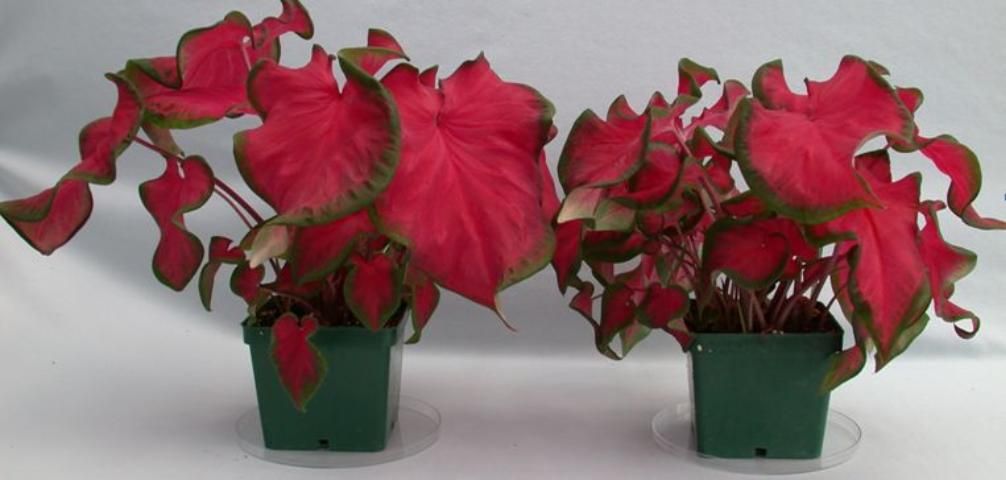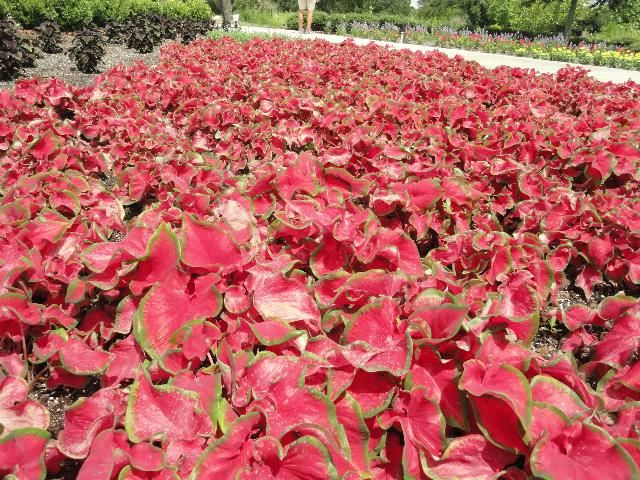Cherry Tart™—A Dwarf Red Lance-Leaved Caladium Variety
Cherry Tart™ is an attractive lance-leaved caladium variety with a novel combination of leaf characteristics (including bright red color, slightly undulate leaf margins, and a broadly cordate leaf shape) (Figures 1 and 2; Deng and Harbaugh 2011). It was released in April 2011 by the University of Florida's Institute of Food and Agricultural Sciences. In replicated field and greenhouse trials, tuber yield and pot plant quality were comparable or superior to 'Florida Red Ruffles' and 'Florida Sweetheart', currently the most popular red lance-leaved commercial variety and the most popular lance-leaved variety, respectively (Bell et al. 1998; Deng et al. 2008). Cherry Tart™ is well suited for producing pot plants and hanging baskets. Tuber de-eyeing produces fuller plants in small or medium containers (4–6 inches), but this practice is not required. Cherry Tart™ produces large numbers of bright red leaves and performs well in sunny and shady landscapes.

Credit: Richard Kelly, UF/IFAS

Credit: Zhanao Deng, UF/IFAS
Origin
Cherry Tart™ was selected in 2001 from progeny of selfed 'Florida Sweetheart', which is a caladium variety from cross-pollinating 'Candidum Junior' and 'Red Frill', two unpatented commercial varieties. 'Candidum Junior' and 'Red Frill' are white fancy-leaved and red lance-leaved varieties, respectively.
Description
Cherry Tart™ plants grown for approximately 4 months in full sun in ground beds had an average height of approximately 12 inches. Leaves are broadly cordate and have slightly undulate margins, averaging 7½ by 5 inches in size. On the upper leaf surface, a dark green margin borders the entire leaf except for the basal leaf valley, where it is gray-purple. The leaf center is also a gray purple. As many as 16 large, gray-purple veins radiate from a central main vein and connect marginally with a thin, gray-purple vein that parallels the leaf margin. Irregular yellow-green mottling may appear along the margin. The leaf undersurface has a yellow-green margin, a red-purple center, and red-purple veins, while the center and veins are covered with gray-white wax. Irregular yellow-green coloration parallels the margin. Leaf petioles are gray purple at the apex, and the colors diffuse into a light gray purple at the base. The upper portion of the petiole below the apex is frequently covered with a gray-white color, and the low portion of the petiole shows a dense distribution of light brown speckles.
Tuber Production
Cherry Tart™ was evaluated for tuber production and plant performance at the UF/IFAS Gulf Coast Research and Education Center in Wimauma, Florida, in 2005 and 2006.
Field plots were arranged in three randomized complete blocks; each plot was 3 feet by 5 feet with 30 plants. New tubers were harvested in November 2005 and December 2006, respectively. Tubers were dried in the greenhouse for approximately 4 weeks and then graded by their maximum diameter: no. 2 (1–1½ inches), no. 1 (1½–2½ inches), jumbo (2½–3½ inches), mammoth (3½–4½ inches), and super mammoth (> 4½ inches). The production index, an indicator of the harvested tubers' economic value, was calculated for each plot as follows: N (no. 2) + 2N (no. 1) + 4N (jumbo) + 6N (mammoth) + 8N (super mammoth), where N = number of tubers in each grade. 'Florida Red Ruffles', 'Florida Sweetheart', and 'Red Frill' (in 2006 only) were included as commercial checks in the trials.
In 2005, tuber weight of Cherry Tart™ (8.2 pounds) was 23 percent greater than that of 'Florida Red Ruffles' (6.6 pounds) and 12 percent greater than that of 'Florida Sweetheart' (7.3 pounds) (Table 1). The production index value for Cherry Tart™ (166.8) was 29 percent and 15 percent higher than that of 'Florida Red Ruffles' (129.7) and 'Florida Sweetheart' (144.3), respectively. Cherry Tart™ produced 58 percent and 38 percent more tubers than 'Florida Red Ruffles' (40.7) and 'Florida Sweetheart'(46.7), respectively.
In 2006, Cherry Tart™ tuber weight was 7.3 pounds, 43 percent and 18 percent higher than that of 'Florida Red Ruffles' (5.1 pounds) and 'Florida Sweetheart' (6.2 pounds), respectively (Table 1), but the difference was not statistically significant. Tuber weight of Cherry Tart™ was 1.75-fold greater than that of 'Red Frill'. In production index and number of marketable tubers, Cherry Tart™ was comparable to 'Florida Red Ruffles' and 'Florida Sweetheart'. Tuber weight for Cherry Tart™ was ~1.8-fold greater and its production index 75 percent greater than that of 'Red Frill'.
Container Forcing and Performance
The suitability of Cherry Tart™ for pot plant production was evaluated by forcing tubers in 4½-inch square containers. No. 1 tubers were planted either intact or de-eyed in a peat/vermiculite mix in March 2007. The evaluation was conducted in a greenhouse with 45 percent light exclusion during the summer in Wimauma, Florida. Three commercial varieties, 'Florida Red Ruffles', 'Florida Sweetheart', and 'Red Frill', were included as the checks.
Cherry Tart™ produced high-quality pot plants regardless of tuber treatments (intact or de-eyed) (Table 2). When tubers were planted intact, Cherry Tart™ sprouted 39 days after planting, which was similar to the sprouting time of 'Florida Red Ruffles' and 'Florida Sweetheart', but 8 days later than 'Red Frill'. Tuber de-eyeing did not cause any change in sprouting time in Cherry Tart™. Intact plants of Cherry Tart™, 'Florida Red Ruffles', and 'Florida Sweetheart' were similar in plant height (6.3–6.8 inches), number of leaves (9.4–10.9), leaf length (6.4–7.0 inches), and leaf width (4.3–4.9 inches). When plants were de-eyed, Cherry Tart™, 'Florida Red Ruffles', and 'Florida Sweetheart' were also similar in plant height (5.7–6.5 inches), number of leaves (13.3–17.2), leaf length (6.5–6.9 inches), and leaf width (4.1–4.8 inches). Pot-grown Cherry Tart™ plants received the highest quality ratings (4.1–4.5) compared to the three commercial varieties (2.8–4.1). Quality pot plants were produced without de-eyeing, but de-eyeing appeared to improve plant quality ratings (from 4.1 to 4.5).
Landscape Performance
Landscape performance of Cherry Tart™ under full sun conditions was evaluated in the same plots used for evaluating tuber production.
Plants of Cherry Tart™ were approximately 3 inches taller than those of 'Florida Red Ruffles' and 'Florida Sweetheart' (Table 3). The most significant difference among the entries was in the leaf number produced per plant (42.7 by Cherry Tart™ vs. 20.9, 21.5, and 26.3 by 'Red Frill', 'Florida Sweetheart', and 'Florida Red Ruffles', respectively) (Table 3). Cherry Tart™ produced full plants with many leaves and bright color display (Figure 3). It received the highest ratings for plant performance among the entries in the trials: 3.4–3.5 in June 2005 and August 2006; 4.0 in September 2006 and July, August, and September 2007; and 4.7–4.8 in July and August 2005 (Table 4). The plant performance rating for Cherry Tart™ was significantly higher than that of 'Florida Red Ruffles' in four out of eight evaluations and significantly higher than that of 'Florida Sweetheart' in six out of eight evaluations. 'Florida Red Ruffles' and 'Florida Sweetheart' are considered to be sunburn-tolerant varieties. Cherry Tart™ received similar sunburn tolerance ratings as 'Florida Red Ruffles' and 'Florida Sweetheart' in all eight evaluations in 3 years.

Credit: Zhanao Deng, UF/IFAS
Recommendation
Cherry Tart™ is a new lance-leaved variety. Plants of Cherry Tart™ are dwarf and suitable for a range of container sizes for pot plant production. Tuber de-eyeing is optional for small containers (4 inches in diameter), although tuber de-eyeing can further enhance plant quality. Cherry Tart™ pot plant production time is similar to the production time for 'Florida Red Ruffles' and 'Florida Sweetheart'. Cherry Tart™ produces large numbers of bright red leaves and can perform well both in sun and under shade.
Availability
The Florida Agricultural Experiment Station has been issued a plant patent for Cherry Tart™ (PP24,680) and production of this variety is to be with a licensing agreement with the Florida Foundation Seed Producers, Inc., P.O. Box 309, Greenwood, FL 32443. Information about tuber availability and propagation agreements can be obtained from the Florida Foundation Seed Producers, Inc.
Literature Cited
Bell, M. L., G. J. Wilfret, and D. A. DeVoll. 1998. "Survey of Caladium Tuber Producers for Acreage of Varieties Grown." Proceedings of the Florida State Horticultural Society 111:32–34.
Deng, Z., and B. K. Harbaugh. 2011. "UF 44-4 – A Dwarf Red Lance-Leaved Caladium Cultivar." HortScience 46(7): 1049-1051.
Deng, Z., B. K. Harbaugh, R. K. Schoellhorn, and R. C. Andrew. 2008. 2003 Survey of the Florida Caladium Tuber Production Industry. ENH1007. Gainesville: University of Florida Institute of Food and Agricultural Sciences. https://edis.ifas.ufl.edu/EP258
Harbaugh, B. K., and B. O. Tjia. 1985. Commercial Forcing of Caladiums. Circular 621. Gainesville: University of Florida Institute of Food and Agricultural Sciences.
Rhodes, H. L. 1964. "Effect of Hot Water Treatment of Seed Tubers and Soil Fumigation for Control of Root Knot on Yield of Caladiums." Plant Disease Reporter 8:568-571.
Tuber weight, production index, number, and grade distribution of Cherry Tart™ and commercial caladium varieties (2005 and 2006).
Plant and leaf characteristics and pot plant quality of Cherry Tart™ and three commercial caladium varieties grown from no. 1 tubers in 4½-inch containers in a 45 percent shaded glasshouse in Wimauma, Florida, in 2007.


